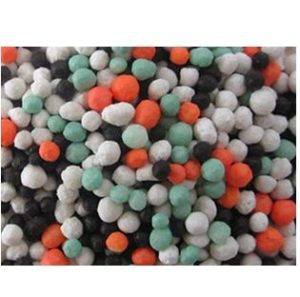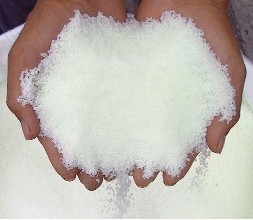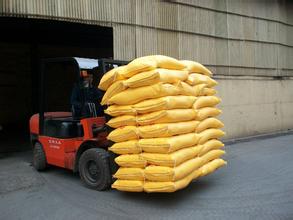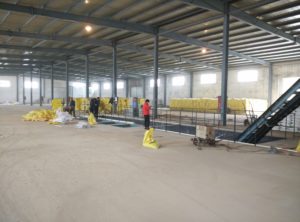What is mixed fertilizer or blended fertilizer and how to get
The mixed fertilizer or bulk blending fertilizer contain two or more of the elements such as nitrogen, phosphorus, and potassium (NPK), etc. which are essential for plant growth and high crop yields. This document has addressed the production of ammonium phosphates (monoammonium phosphate, or MAP, and diammonium phosphate, or DAP), nitrophosphates, potash, and compound fertilizers. Ammonium phosphates are produced by mixing phosphoric acid and anhydrous ammonia in a reactor to produce a slurry. (This is the mixed acid route for producing NPK fertilizers; potassium and other salts are added during the process.) The slurry is sprayed onto a bed of recycled solids in a rotating granulator, and ammonia is sparged into the bed from underneath. Granules pass to a rotary dryer followed by a rotary cooler. Solids are screened and sent to storage for bagging or for bulk shipment. Nitrophosphate fertilizer is made by digesting phosphate rock with nitric acid. This is the nitrophosphate route leading to NPK fertilizers; as in the mixed-acid route, potassium and other salts are added during the process.
 The resulting solution is cooled to precipitate calcium nitrate, which is removed by filtration. The filtrate is neutralized with ammonia, and the solution is evaporated to reduce the water content. Prilling may follow. The calcium nitrate filter cake can be further treated to produce a calcium nitrate fertilizer, pure calcium nitrate, or ammonium nitrate and calcium carbonate. Nitrophosphate fertilizers are also produced by the mixed-acid process, through digestion of the phosphate rock by a mixture of nitric and phosphoric acids. Potash (potassium carbonate) and sylvine (potassium chloride) are solution-mined from deposits and are refined through crystallization processes to produce fertilizer. Potash may also be dry-mined and purified by flotation. Compound fertilizers can be made by blending basic fertilizers such as ammonium nitrate, MAP, DAP, and granular potash; this route may involve a granulation process. Waste Characteristics Air Emissions The principal pollutants from the production of MAP and DAP are ammonia and fluorides, which are given off in the steam from the reaction. Fluorides and dust are released from materials-handling operations. Ammonia in uncontrolled air emissions has been reported to range from 0.1 to 7.8 kilograms of nitrogen per metric ton (kg/t) of product, with phosphorus ranging from 0.02 to 2.5 kg/t product (as phosphorous pentoxide, P2O5). In nitrophosphate production, dust will also contain fluorides. Nitrogen oxides (NOx) are given off at the digester. In the evaporation stage, fluorine compounds and ammonia are released.
The resulting solution is cooled to precipitate calcium nitrate, which is removed by filtration. The filtrate is neutralized with ammonia, and the solution is evaporated to reduce the water content. Prilling may follow. The calcium nitrate filter cake can be further treated to produce a calcium nitrate fertilizer, pure calcium nitrate, or ammonium nitrate and calcium carbonate. Nitrophosphate fertilizers are also produced by the mixed-acid process, through digestion of the phosphate rock by a mixture of nitric and phosphoric acids. Potash (potassium carbonate) and sylvine (potassium chloride) are solution-mined from deposits and are refined through crystallization processes to produce fertilizer. Potash may also be dry-mined and purified by flotation. Compound fertilizers can be made by blending basic fertilizers such as ammonium nitrate, MAP, DAP, and granular potash; this route may involve a granulation process. Waste Characteristics Air Emissions The principal pollutants from the production of MAP and DAP are ammonia and fluorides, which are given off in the steam from the reaction. Fluorides and dust are released from materials-handling operations. Ammonia in uncontrolled air emissions has been reported to range from 0.1 to 7.8 kilograms of nitrogen per metric ton (kg/t) of product, with phosphorus ranging from 0.02 to 2.5 kg/t product (as phosphorous pentoxide, P2O5). In nitrophosphate production, dust will also contain fluorides. Nitrogen oxides (NOx) are given off at the digester. In the evaporation stage, fluorine compounds and ammonia are released.
Unabated emissions for nitrogen oxides from selected processes are less than 1,000 milligrams per cubic meter (mg/m3) from digestion of phosphate rock with nitric acid, 50–200 mg/m3 from neutralization with ammonia, and 30–200 mg/ m3 from granulation and drying. Dust is the primary air pollutant from potash manufacturing. Liquid Effluents The volumes of liquid effluents from mixed fertilizer plants are reported to range from 1.4 to 50 Pollution Prevention and Abatement Handbook WORLD BANK GROUP Effective July 1998 346 PROJECT GUIDELINES: INDUSTRY SECTOR GUIDELINES cubic meters per metric ton (m3/t) of product. Where water is used in scrubbers, the scrubbing liquors can usually be returned to the process. Effluents can contain nitrogen, phosphorus, and fluorine; the respective ranges of concentrations can be 0.7–15.7 kg/t of product (as N), 0.1–7.8 kg/t of product (as P2O5), and 0.1–3.2 kg/t of product. Solid Wastes Generally, there is little solid waste from a fertilizer plant, since dust and fertilizer spillage can be returned to the process. Pollution Prevention and Control Materials handling and milling of phosphate rock should be carried out in closed buildings. Fugitive emissions can be controlled by, for example, hoods on conveying equipment, with capture of the dust in fabric filiters. In the ammonium phosphate plant, the gas streams from the reactor, granulator, dryer, and cooler should be passed through cyclones and scrubbers, using phosphoric acid as the scrubbing liquid, to recover particulates, ammonia, and other materials for recycling. In the nitrophosphate plant, nitrogen oxide (NOx) emissions should be avoided by adding urea to the digestion stage. Fluoride emissions should be prevented by scrubbing the gases with water. Ammonia should be removed by scrubbing. Phosphoric acid may be used for scrubbing where the ammonia load is high. The processwater system should be balanced, if necessary, by the use of holding tanks to avoid the discharge of an effluent. Treatment Technologies Additional pollution control devices—beyond the scrubbers, cyclones, and baghouses that are an integral part of the plant design and operations—are generally not required for mixed fertilizer plants. Good housekeeping practices are essential to minimize the amount of spilled material. Spills or leaks of solids and liquids should be returned to the process.

Liquid effluents, if any, need to be controlled for total suspended solids, fluorides, phosphorus, and ammonia. Modern plants using good industrial practices are able to achieve the pollutant loads discussed below. Air Emissions Table 1 shows the emissions values that have been reported for the manufacture of NPK fertilizers by the nitrophosphate route and that should be attained in a well-operated plant. For NPK fertilizers produced by the mixed-acid route, the emissions loadings presented in Table 2 are attainable. Liquid Effluents An effluent discharge of less than 1.5 m3/t product as P2O5 is realistic, but use of holding ponds makes feasible a discharge approaching zero. Table 3 shows the pollutant loads in effluents reported for NPK fertilizers produced by the nitrophosphate route. Emissions Guidelines Emissions levels for the design and operation of each project must be established through the Table 1. Emissions Loadings for Mixed Fertilizer Plants, Nitrophosphate Process (kilograms per ton of NPK fertilizer produced) Parameter Loading Ammonia (NH3 as N) 0.3 Nitrogen oxides (as NO2) 0.2 Fluoride (as fluorine) 0.02 PM 0.3 Table 2. Emissions Loadings for Mixed Fertilizer Plants, Mixed-Acid Process (kilograms per ton of NPK fertilizer produced) Parameter Loading Ammonia nitrogen (NH4–N, including free ammonia) 0.01 Fluoride (as fluorine) 0.01 PM 0.2 Note: Loadings can vary widely, depending on the grade of fertilizer produced. Mixed Fertilizer Plants 347 environmental assessment (EA) process on the basis of country legislation and the Pollution Prevention and Abatement Handbook, as applied to local conditions. The emissions levels selected must be justified in the EA and acceptable to the World Bank Group. The guidelines given below present emissions levels normally acceptable to the World Bank Group in making decisions regarding provision of World Bank Group assistance. Any deviations from these levels must be described in the World Bank Group project documentation. The emissions levels given here can be consistently achieved by well-designed, welloperated, and well-maintained pollution control systems. The guidelines are expressed as concentrations to facilitate monitoring. Dilution of air emissions or effluents to achieve these guidelines is unacceptable. All of the maximum levels should be achieved for at least 95% of the time that the plant or unit is operating, to be calculated as a proportion of annual operating hours. Air Emissions The emissions levels presented in Table 4 should be achieved. Liquid Effluents The effluent levels presented in Table 5 should be achieved. Wastewater treatment discharges are sometimes used for agricultural purposes and may contain heavy metals. Of particular concern is the cadmium content.

Ambient Noise Noise abatement measures should achieve either the levels given below or a maximum increase in background levels of 3 decibels (measured on the A scale) [dB(A)]. Measurements are to be taken at noise receptors located outside the project property boundary. Maximum allowable log equivalent (hourly measurements), in dB(A) Day Night Receptor (07:00–22:00) (22:00–07:00) Residential, institutional, educational 55 45 Industrial, commercial 70 70 Monitoring and Reporting Frequent sampling may be required during startup and upset conditions. Once a record of consistent performance has been established, sampling for the parameters listed in the tables should be as described below. Table 3. Pollutant Loads in Effluents, Mixed Fertilizer Plants, Nitrophosphate Process (kilograms per ton of NPK fertilizer produced) Parameter Loading P2O5 0.06 NH4–N 0.012 Nitrate nitrogen (NO3–N) 0.03 Fluoride (as fluorine) 0.05 Table 4. Air Emissions from Mixed Fertilizer Plants (milligrams per normal cubic meter) Parameter Maximum value PM 50 Ammonia (NH3 as N) 50 Fluorides (as fluorine) 5 Nitrogen oxides (as NO2) Nitrophosphate unit 500 Mixed-acid unit 70 Table 5. Effluents from Mixed Fertilizer Plants (milligrams per liter, except for pH) Parameter Maximum value pH 6–9 TSS 50 Fluorides (as fluorine) 20 Total metals 10 Cadmium 0.1 Phosphorus 5 Ammonia (NH4–N) 10 Note: Effluent requirements are for direct discharge to surface waters. 348 PROJECT GUIDELINES: INDUSTRY SECTOR GUIDELINES Air emissions at point of discharge are to be monitored continuously for fluorides and particulates and annually for ammonia and nitrogen oxides. Liquid effluents should be continuously monitored for pH. Other parameters are to be monitored at least weekly. Monitoring data should be analyzed and reviewed at regular intervals and compared with the operating standards so that any necessary corrective actions can be taken. Records of monitoring results should be kept in an acceptable format. The results should be reported to the responsible authorities and relevant parties, as required. Key Issues The key production and control practices that will lead to compliance with emissions requirements can be summarized as follows: • Maximize product recovery and minimize air emissions by appropriate maintenance and operation of scrubbers and baghouses. • Eliminate effluent discharges by operating a balanced process water system. • Prepare and implement an emergency preparedness and response plan. Such a plan is required because of the large quantities of ammonia and other hazardous materials stored and handled on site. Sources Bounicore, Anthony J., and Wayne T. Davis, eds. 1992. Air Pollution Engineering Manual. New York: Van Nostrand Reinhold. European Fertilizer Manufacturers’ Association. 1995a. “Production of NPK Fertilizers by the Nitrophosphate Route.” Booklet 7 of 8. Brussels. ————. 1995b. “Production of NPK Fertilizers by the Mixed Acid Route.” Booklet 8 of 8. Brussels. Sauchelli, Vincent. 1960. Chemistry and Technology of Fertilizers. New York: Reinhold Publishing. Sittig, Marshall. 1979. Fertilizer Industry; Processes, Pollution Control and Energy Conservation. Park Ridge, N.J.: Noyes Data Corporation. UNIDO (United Nations Industrial Development Organization). 1978. Process Technologies for Nitrogen Fertilizers. New York. ————. 1978. Process Technologies for Phosphate Fertilizers. New York. World Bank. 1996. “Pollution Prevention and Abatement: Mixed Fertilizer Plants.” Draft Technical Background Document. Environment Department, Washington, D.C.

I see you don’t monetize your page, don’t waste your traffic, you can earn extra bucks every month.
You can use the best adsense alternative for any type of
website (they approve all websites), for more details simply search in gooogle: boorfe’s tips
monetize your website
beidouace.com is interesting, i will come back here for
sure
Your kindness!